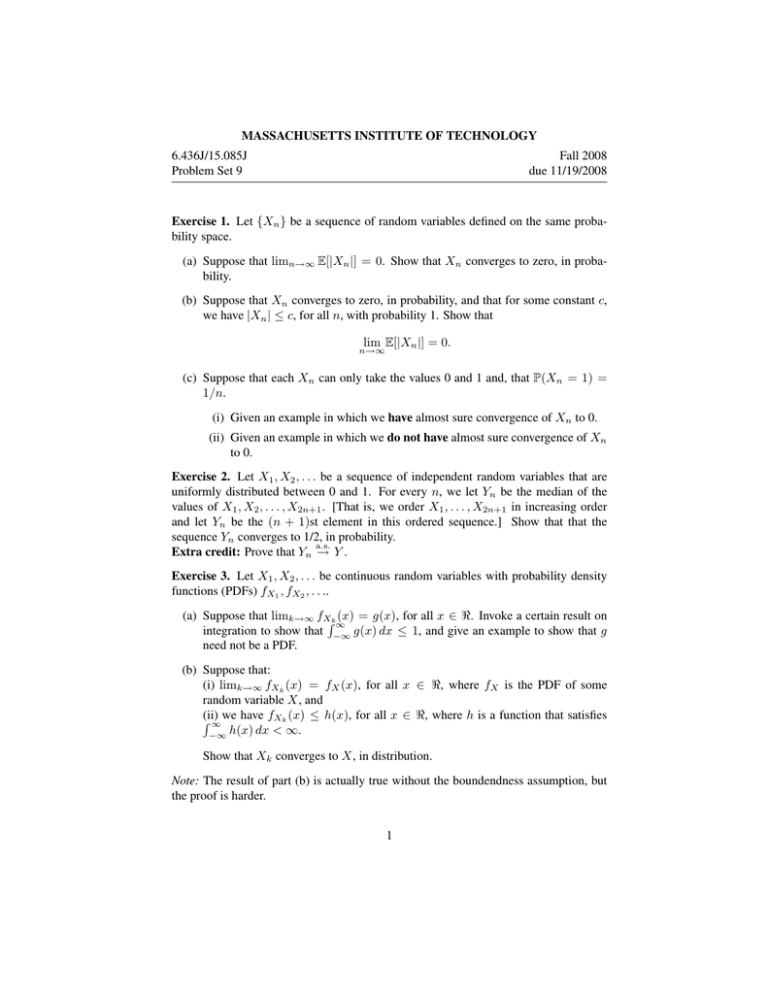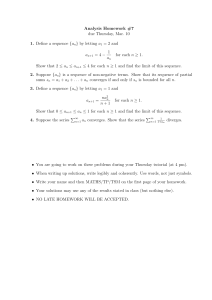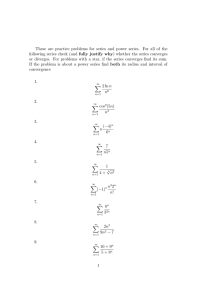MASSACHUSETTS INSTITUTE OF TECHNOLOGY 6.436J/15.085J Fall 2008 Problem Set 9
advertisement

MASSACHUSETTS INSTITUTE OF TECHNOLOGY
6.436J/15.085J
Problem Set 9
Fall 2008
due 11/19/2008
Exercise 1. Let {Xn } be a sequence of random variables defined on the same proba­
bility space.
(a) Suppose that limn→∞ E[|Xn |] = 0. Show that Xn converges to zero, in proba­
bility.
(b) Suppose that Xn converges to zero, in probability, and that for some constant c,
we have |Xn | ≤ c, for all n, with probability 1. Show that
lim E[|Xn |] = 0.
n→∞
(c) Suppose that each Xn can only take the values 0 and 1 and, that P(Xn = 1) =
1/n.
(i) Given an example in which we have almost sure convergence of Xn to 0.
(ii) Given an example in which we do not have almost sure convergence of Xn
to 0.
Exercise 2. Let X1 , X2 , . . . be a sequence of independent random variables that are
uniformly distributed between 0 and 1. For every n, we let Yn be the median of the
values of X1 , X2 , . . . , X2n+1 . [That is, we order X1 , . . . , X2n+1 in increasing order
and let Yn be the (n + 1)st element in this ordered sequence.] Show that that the
sequence Yn converges to 1/2, in probability.
a.s.
Extra credit: Prove that Yn → Y .
Exercise 3. Let X1 , X2 , . . . be continuous random variables with probability density
functions (PDFs) fX1 , fX2 , . . ..
(a) Suppose that limk→∞ fX�k (x) = g(x), for all x ∈ �. Invoke a certain result on
∞
integration to show that −∞ g(x) dx ≤ 1, and give an example to show that g
need not be a PDF.
(b) Suppose that:
(i) limk→∞ fXk (x) = fX (x), for all x ∈ �, where fX is the PDF of some
random variable X, and
(ii)
� ∞ we have fXk (x) ≤ h(x), for all x ∈ �, where h is a function that satisfies
h(x) dx < ∞.
−∞
Show that Xk converges to X, in distribution.
Note: The result of part (b) is actually true without the boundendness assumption, but
the proof is harder.
1
Exercise 4. The following fact is known, and can be used in this problem: if a sequence
of normal random variables Xk converges in distribution to a random variable X, then
X is normal.
Suppose that for every k, the pair (Xk , Y ) has a bivariate normal distribution. Fur­
thermore, suppose that the sequence Xk converges to X, almost surely. Show that
(X, Y ) has a bivariate normal distribution. Hint: Use the “right” definition of the bi­
variate normal.
Exercise 5. Let X1 , X2 , . . . be a sequence of i.i.d. normal random variables, with zero
2
mean and unit variance. The corresponding characteristic function is E[eitX1 ] = e−t /2 .
We would like to define a new random variable
∞
�
Xk
k=1
2k
.
More precisely, we need to consider the finite sum
Yn =
n
�
Xk
k=1
2k
,
and investigate whether it converges to a limit in some sense.
(a) Use transforms to prove that Yn converges in distribution, and to identify the
nature of the limit distribution. (Please state the facts that you are using.)
(b) Prove that Yn converges to a random variable Y which is finite, with probability
one. Hint: Consider the sum of |Xk |/2k .
Exercise 6. (a) Consider two sequences of random variables, {Xi } and {Yi }. Sup­
pose that Xi converges to a ∈ R, in probability, and Yi converges to b ∈ R, in
probability. Show that Xi + Yi converges to a + b, in probability.
(b) Suppose that {Xi } is a sequence of independent identically distributed random
variables that converges in probability to a random variable X. Show that X must
be a constant almost surely.
2
MIT OpenCourseWare
http://ocw.mit.edu
6.436J / 15.085J Fundamentals of Probability
Fall 2008
For information about citing these materials or our Terms of Use, visit: http://ocw.mit.edu/terms.




